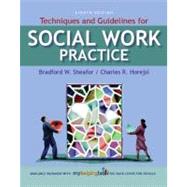
| Preface | |
| Social Work And The Social Worker | |
| The Domain of the Social Work Profession | |
| The Social Work Domain | |
| An Overview of Social Work Practice | |
| Merging Person with Profession | |
| Selecting Social Work as a Career | |
| Establishing Oneself as a Social Worker | |
| The Interplay of One's Personal and Professional Lives | |
| A Fitness Program for the Social Worker | |
| Having Fun in Social Work | |
| Merging the Person's Art with the Profession's Science | |
| The Social Worker as Artist | |
| The Social Worker as Scientist | |
| The Building Blocks Of Social Work Practice | |
| The Roles and Functions Performed by Social Workers | |
| Defining Professional Roles | |
| Guiding Principles for Social Workers | |
| Principles Focused on the Social Worker | |
| Principles that Guide Practice Activities | |
| Practice Frameworks for Social Work | |
| Requirements of a Practice Framework | |
| Guidelines for Selecting a Practice Framework | |
| Selected Practice Frameworks | |
| Selected Practice Theories and Models | |
| Facilitating Change Through Decision Making | |
| Elements of the Planned Change Process | |
| The Context of Planned Change | |
| Factors Affecting Clients' Need for Change | |
| Identifying the Actors in Planned Change | |
| Phases of the Planned Change Process | |
| Critical Thinking in Planned Change | |
| Decision Making in Planned Change | |
| Techniques Common To All Social Work Practice | |
| Basic Communication and Helping Skills | |
| Creating an Effective Helping Relationship | |
| Verbal Communication Skills | |
| Nonverbal Communication | |
| Helping Skills | |
| The "I-Statement." | |
| Understanding Emotions and Feelings | |
| Responding to Defensive Communication | |
| Elements of Professional Behavior | |
| Making Ethical Decisions | |
| Using Cultural Competence in Helping | |
| Basic Skills for Agency Practice | |
| Report Writing | |
| Letter Writing | |
| Effective Telephone Communications | |
| Using Information Technology | |
| Maintaining Casenotes for Narrative Recording | |
| Problem-Oriented Recording (POR) and the SOAP Format | |
| Managing Time at Work | |
| Controlling Workload | |
| Planning for a Temporary Absence | |
| Techniques And Guidelines For Phases Of The Planned Change Process | |
| Intake and Engagement | |
| Introduction | |
| Techniques and Guidelines for Direct Practice | |
| Techniques and Guidelines for Indirect Practice | |
| Data Collection and Assessment | |
| Techniques and Guidelines for Direct Practice | |
| Techniques and Guidelines for Indirect Practice | |
| Planning and Contracting | |
| Techniques and Guidelines for Direct Practice | |
| Techniques and Guidelines for Indirect Practice | |
| Intervention and Monitoring | |
| Techniques and Guidelines for Direct Practice | |
| Techniques and Guidelines for Indirect Practice | |
| Evaluation and Termination | |
| Techniques and Guidelines for Direct Practice | |
| Techniques and Guidelines for Indirect Practice | |
| Specialized Techniques And Guidelines For Social Work Practice | |
| Guidelines for Working With Vulnerable Client Groups | |
| The Client Who Is Poor | |
| The Client Who Is a Child.< | |
| Table of Contents provided by Publisher. All Rights Reserved. |
The New copy of this book will include any supplemental materials advertised. Please check the title of the book to determine if it should include any access cards, study guides, lab manuals, CDs, etc.
The Used, Rental and eBook copies of this book are not guaranteed to include any supplemental materials. Typically, only the book itself is included. This is true even if the title states it includes any access cards, study guides, lab manuals, CDs, etc.